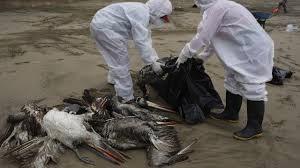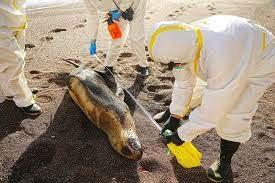 A research team of epidemiologists, molecular virologists and wildlife biologists affiliated to the Pontificia Universidad Catolica del Peru in conjunction with scientists at the National Center for Biotechnology of Infection at the U. S. National Institutes of Health (NIH) recently published* on studies conducted on H5N1 isolates prevalent along the Pacific coast. Samples were obtained from dead marine mammals and birds that yielded avian influenza strain H5N, lineage 2.3.4.4b. This pathogen was introduced to the Pacific coast of South America during October 2022 by migratory marine birds.
A research team of epidemiologists, molecular virologists and wildlife biologists affiliated to the Pontificia Universidad Catolica del Peru in conjunction with scientists at the National Center for Biotechnology of Infection at the U. S. National Institutes of Health (NIH) recently published* on studies conducted on H5N1 isolates prevalent along the Pacific coast. Samples were obtained from dead marine mammals and birds that yielded avian influenza strain H5N, lineage 2.3.4.4b. This pathogen was introduced to the Pacific coast of South America during October 2022 by migratory marine birds.
Sequencing of the isolates revealed the presence of a specific mutation PB2 V701N in samples from both sea lions and a human case in Chile. This mutation is associated with adaptation of an avian virus to mammalian hosts and includes the capacity for enhanced transmission.
An immediate concern relates to mortality in endangered species including the Andean Condor,(Vultur gryphus), Humboldt Penguins (Spheniscus humboldti) and Marine Otters.(Lontra felina) A further consideration relates to the possibility of adaptation to human hosts with person-to-person transmission.
 Accordingly, education programs have been initiated to warn beach goers of the danger of contact with dead mammals and birds. The need for constant surveillance of avian influenza viruses responsible for mortality in avian and mammalian species is necessary to detect mutations and predict possible zoonotic outbreaks.
Accordingly, education programs have been initiated to warn beach goers of the danger of contact with dead mammals and birds. The need for constant surveillance of avian influenza viruses responsible for mortality in avian and mammalian species is necessary to detect mutations and predict possible zoonotic outbreaks.
Studies conducted in Peru were funded by a grant from the NIH National Institute of Allergy and Infectious Diseases: -
*Leguia, N. et al. Highly Pathogenic Avian Influenza A (H5N1) in Marine Mammals and Sea Birds in Peru. Nature Communications doi:10.1038/s41467-023-41182-0 (2023)